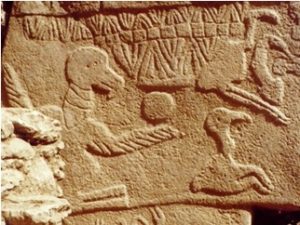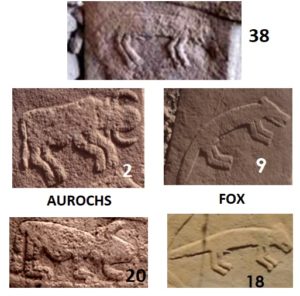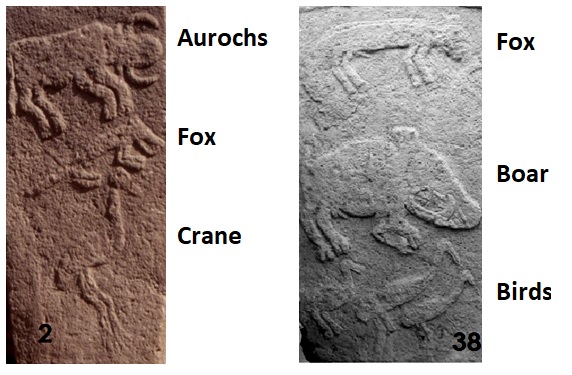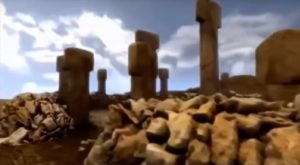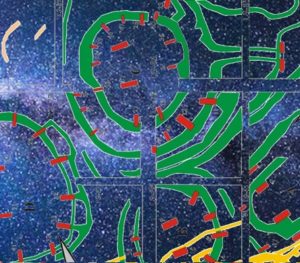 Does Gobekli Tepe encode advanced astronomical knowledge, and validate the Younger Dryas Impact Hypothesis along the way? I’ve discussed the context, archaeology, and general alterno claims about the site in previous posts. Now it’s time to look to the stars.
Does Gobekli Tepe encode advanced astronomical knowledge, and validate the Younger Dryas Impact Hypothesis along the way? I’ve discussed the context, archaeology, and general alterno claims about the site in previous posts. Now it’s time to look to the stars.
Ancient peoples no doubt observed the stars, navigated by them, observed how they changed from season to season. They no doubt engaged in the very human game of pareidolia, saw patterns in the sky, made up stories about them—patterns and stories that differed demonstrably from culture area to culture area, a testament to the fertile human imagination. This does not mean that sky-lore was built into every ancient 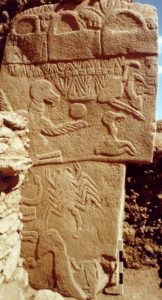 monument, nor that it dominated ancient religious thought, nor that their techniques of observation were particularly sophisticated; and yet, finding astronomical orientations in ancient monuments, and building towers of speculation on top of them, is a cottage industry among archaeological alternos.
monument, nor that it dominated ancient religious thought, nor that their techniques of observation were particularly sophisticated; and yet, finding astronomical orientations in ancient monuments, and building towers of speculation on top of them, is a cottage industry among archaeological alternos.
Predictably, Gobekli Tepe is the subject of several conflicting astronomical claims involving the orientation of the great enclosures and the profusion of animals and other symbols on the T-shaped pillars. Pillar 43 from Enclosure D, the so-called “Vulture Stone,” receives special attention, particularly the scorpion, the vulture with outstretched wings, and the circle above one of the vulture’s wings. The central assumption of all this is that the animals pictured were constellations and other heavenly features, as opposed to—say—animals. Here are a few examples.
Magli focusses on Sirius: the orientations of Enclosures B, C, and D track its rising through the 9th and 10th centuries BC. The circle being delicately lifted by one of the vulture’s wings may represent the heliacal rising of Sirius a few days before the summer solstice.
Collins and Hale: the vulture is both Cygnus (with the vulture’s eye marking the bright star Deneb) and a superconstellation embracing Cygnus, Aquila, and Lyra (with Deneb hitting somewhere on the bird’s beak). The circle is the north celestial pole, the “turning point of the heavens.” The overall interpretation involves ushering the deceased soul into the realm of the dead, which at least makes reasonable cultural sense.
Timothy Stephany: the vulture is Pegasus with a dash of Andromeda and some lesser stars. The “huts” at the top form a backbone, signifying the Milky Way; the scorpion does not correspond to a constellation, but takes in some stars of Aquarius. The circle also does not match anything in particular, so may be a supernova or full moon. He does go on (and on) to include all the iconography at GT, but does not tie his “neolithic constellations” into modern ones, which is rather refreshing. He simply fiddles with the GT reliefs until they sorta kinda match a bit of the night sky.
Clearly, there is diversity of opinion among those who see astronomical significance in Gobekli Tepe’s structures, and a certain amount of subjectivity in matching the “constellations.” ( I note that nobody seems very interested in the planets, the “wandering stars,” though they loom large in later astrologies). But two engineers at Edinburgh University, Martin Sweatman and Dimitrios Tsikritsis, claim to blow all those other astronomical speculations right out of the water.
In 2017, they published a peer-reviewed paper claiming hard evidence that the people of Gobekli Tepe had advanced astronomical skills, were aware of precession, and had clearly spent many centuries, even millennia, recording the movements of the heavenly bodies. Furthermore, Pillar 43 was a “date-stamp” for the summer solstice of 10,950 ± 250 BC, which the authors link directly to the Younger Dryas Impact event. And it’s all proven by irrefutable statistics, so it must be right, and all those other guys must be wrong. Unfortunately, it’s one of the finest examples of GIGO (Garbage In, Garbage Out) that I’ve seen in many years.
They started with two assumptions common among alternos: first, that the animals pictured in Gobekli Tepe were constellations, arranged meaningfully on the pillars; second, that the Younger Dryas Impact happened, and made a huge impression on its survivors. After matching constellations with animals on the long-suffering Pillar 43 to their own satisfaction, and interpreting the “huts” along the top edge of the pillar as symbols of equinoxes or solstices, they ran statistical tests to see if their correlations were both significant, and significantly tied in with the notional date of the Younger Dryas Impact. Not surprisingly, the results were dazzlingly significant—so much so, in fact, that Sweatman and Tsiskritsis claim any other interpretation of those images can be junked out of hand.
But the argument is circular: if you identify the members of Set A (animal images) with the members of Set B, which are related to each other by definition (the asterisms), then you will inevitably find that Set A tests out as significantly related, more so than other possible combinations of animal images. Sweatman and Tsikritsis were not testing whether the astronomical proposal was valid; they were essentially testing whether their non-randomly selected Set A was non-random. The first question then must be, how reliable was the identification of Set A with Set B? And there, problems arise.
The Star Map
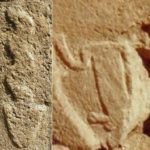 They assume that all animal figures represent constellations—except snakes, which represent meteors, and the little headless ithyphallic man on Pillar 43, who somehow symbolizes the dire human consequences of the YDI catastrophe. Sweatman and Tsikritsis construe the arrangement of some animals on Pillar 43 as a map of the stars, and identify the constellations by their proximity to each other, and by a markedly subjective looks-like-therefore-is approach using the magic of Stellarium. They do not attempt to interpret all the images on the pillar, and admit the positions are only approximate, but feel they are close enough to convey the message intended by the creators.
They assume that all animal figures represent constellations—except snakes, which represent meteors, and the little headless ithyphallic man on Pillar 43, who somehow symbolizes the dire human consequences of the YDI catastrophe. Sweatman and Tsikritsis construe the arrangement of some animals on Pillar 43 as a map of the stars, and identify the constellations by their proximity to each other, and by a markedly subjective looks-like-therefore-is approach using the magic of Stellarium. They do not attempt to interpret all the images on the pillar, and admit the positions are only approximate, but feel they are close enough to convey the message intended by the creators.
The starting point is the scorpion, representing a portion of Scorpio. The vulture 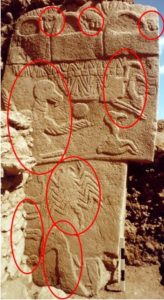 above it, with its hooked beak and distinctive feathered wings, is thus Sagittarius, and the bird-head below it is Libra. To the right of the vulture, the bird with its long legs stretched oddly before it is identified as a crane, and combined with the bird-headed snaky thing beside it to form Ophiuchus. To the left of the scorpion, only partially visible, is what they interpret as a dog or wolf, identified with Lupus. The smaller-scale animals beside the handbag-shaped objects at the top are identified as Pisces (crane), Gemini (ibex/charging quadruped), and Virgo (frog; later, bear). Those eight identifications are what the first statistical analysis was based on, but there are substantive problems with several of them.
above it, with its hooked beak and distinctive feathered wings, is thus Sagittarius, and the bird-head below it is Libra. To the right of the vulture, the bird with its long legs stretched oddly before it is identified as a crane, and combined with the bird-headed snaky thing beside it to form Ophiuchus. To the left of the scorpion, only partially visible, is what they interpret as a dog or wolf, identified with Lupus. The smaller-scale animals beside the handbag-shaped objects at the top are identified as Pisces (crane), Gemini (ibex/charging quadruped), and Virgo (frog; later, bear). Those eight identifications are what the first statistical analysis was based on, but there are substantive problems with several of them.
Vulture/Sagittarius. The distinctive vulture with outspread wings also appears on a slab from the same enclosure, with completely different neighbours: a hyena and a long-legged quadruped. The only detail in common is the circle appearing above the vulture’s wing, which Sweatman and Tsikritsis interpret as the sun on Pillar 43, and the archaeologists as a decapitated head on both images. On Pillar 56 from Enclosure H, the vulture is part of a dense crowd of birds, snakes, and predators, which again do not match the arrangement on Pillar 43. How valid is it to cherry-pick one of these “neighbourhoods” as a map of the sky?
Lupus/Wolf. The partially hidden image that Sweatman and Tsikritsis see here as a dog or wolf is the same image that they see elsewhere as a fox, and identify with the northern asterism of Aquarius. Note also that “Lupus” was first applied to that group of stars in the 2nd century AD; earlier star maps made it part of Centaurus, or an unidentified beast associated with Centaurus.
Ibex/Gemini. The creature has a long tail across its back, which Sweatman and Tsikritsis seem to have missed. Iconographically, it is closest to the lion images, and the fierce high-relief predator on Pillar 27. Elsewhere, Sweatman identifies lion/leopard images with Cancer.
Crane/Pisces and Crane+Fish/Ophiuchus. Birds are all over the place on the GT pillars, in several distinct forms, and usually in groups of two or more. If the bending crane is Pisces, what would a whole cluster of bending cranes denote in astronomical terms? And if the bird is sometimes a constellation and sometimes a bird, how do you reliably tell which is which? The best illustration of this is Pillar 56, with its multiple examples of both birds which were identified as constellations on Pillar 43.
Inconsistencies like these do not exactly create confidence in Sweatman and Tsikritsis’s methodology. I would say that, out of eight matches used in the statistical analysis, at least five are iffy enough to qualify as Garbage In (and I’m not too sure about Libra, either.) That is surely enough to guarantee Garbage Out on that portion of the paper.
Pillars 2 and 38
Apart from Pillar 43, the only other pillars treated in detail by Sweatman and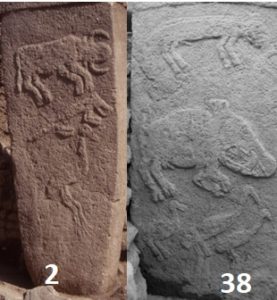 Tsikritsis are Pillar 38 from the same enclosure, and Pillar 2 from somewhat-younger Enclosure A. These were chosen because each pillar features three stacked images: aurochs, fox, and crane on Pillar 2; aurochs, boar, and crane on Pillar 38. On the face of it, as they admit, this would seem to falsify the constellation hypothesis, as different animals interpose between the aurochs and the crane on the two pillars, and how could that be matched with the sky? However, they turn it into a triumph of confirmation, via a dizzying multi-stepped logic trail involving the proposal that GT’s prime focus was observing meteors, the Taurids in particular, as the Taurids were the source for the notional Younger Dryas impacter.
Tsikritsis are Pillar 38 from the same enclosure, and Pillar 2 from somewhat-younger Enclosure A. These were chosen because each pillar features three stacked images: aurochs, fox, and crane on Pillar 2; aurochs, boar, and crane on Pillar 38. On the face of it, as they admit, this would seem to falsify the constellation hypothesis, as different animals interpose between the aurochs and the crane on the two pillars, and how could that be matched with the sky? However, they turn it into a triumph of confirmation, via a dizzying multi-stepped logic trail involving the proposal that GT’s prime focus was observing meteors, the Taurids in particular, as the Taurids were the source for the notional Younger Dryas impacter.
Apparently, in 9530 BC, the radiants of the northern and southern Taurid meteor streams passed between Capricorn and Pisces via the northern and southern parts of Aquarius, respectively. Since the crane had already been identified as Pisces, that would make the aurochs into Capricorn, and the fox and boar into northern and southern Aquarius, respectively. Oh, and would also support the idea that GT was obsessed with the Taurid meteor showers, and that Pillar 43 was a memorial to the Younger Dryas Impact.
Problem #1: Pillar 2 certainly shows the sequence aurochs/fox/crane. But Pillar 38’s topmost animal is clearly not an aurochs, but a fox. Sweatman and Tsikritsis’s rationale for revising the excavators’ determination is found only in a brief note in the references, and makes no sense at all.
The bottom image is not the distinctive bent-legged crane shown on Pillars 2 and 43, but a group of three birds, a duck and two cranes. Therefore, the sequence is not aurochs/boar/crane, but fox/boar/birds. And since the bottom figure is not the Pisces previously proposed, then the identifications of the other figures as Capricorn and Aquarius break down, as does the extraordinarily tenuous conclusions that followed.
Problem #2: There is, in fact, a third pillar with three stacked images, Pillar 20 from Enclosure D. There, the sequence is snake/aurochs/fox, which would invalidate one or another of Sweatman and Tsikritsis’s core assumptions. Either the snake is, after all, a constellation; or the triads do not, after all, represent three stacked constellations.
Let’s summarize what has just happened. Incorrectly and/or inconsistently identified images, interpreted according to baseless assumptions, were used to shore up a stream of wild speculation. No veneer of GIGO statistics, Stellarium screencaps, or ingenious leaps of logic can turn this farrago into science.
And what an impoverished vision of the Gobekli Tepe phenomenon this is, jamming a vibrant culture into the straitjacket of a modern obsession—as if the ability to track precession and record equinoxes from a thousand years back were valid measures of an ancient society’s worth.
In fact, the rich iconography of Gobekli Tepe suggests an equally rich mythology and a repertoire of entertaining narratives that we can only guess at so far. The little headless cadaver on Pillar 43 links into widespread contemporary concepts of the relationship between the living and the dead. The bent cranes with their humanoid legs hint at masquerading dancers involved in colourful shamanistic celebrations—possibly with beer.
Yes indeed, Gobekli Tepe is a hell of a site. It deserves to be evaluated for what it was, rather than what the alternos need it to be.
Further reading:
http://maajournal.com/Issues/2017/Vol17-2/Matters%20arising%2017%282%29.pdf
The same journal that published Sweatman and Tsikritsis’s original paper allowed the excavators to respond, and the authors to rebut. At the end is a critique by Graham Hancock’s favourite archaeoastronomer, Paul D. Burley, who is intrigued by the thesis but not terribly impressed by the star map.
http://www.andrewcollins.com/page/articles/sagittarius.htm
Alterno Andrew Collins critiques Sweatman and Tsikritsis, with a side-swipe at Burley.

